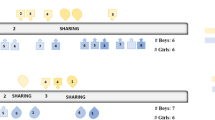Abstract
An observational study investigated the effects of gender of teacher, gender of student, and classroom subject (mathematics vs. English literature/language) on teacher–student interactions. A total of 597 high school students (294 males and 303 females) and 36 teachers (28 males and 8 females) were observed in either 18 mathematics classes or 18 literature/language classes. Students and teachers were predominately Caucasian, with the majority of students from a lower- or middle-class background. Observations were coded using the interactions for sex equity in classroom teaching (INTERSECT) observational instrument. It was found that female mathematics teachers, male literature/language teachers, and female literature/language teachers tended to interact somewhat more with male students than with female students. This tendency was not the result of male students having initiated more direct verbal interactions with teachers.
Similar content being viewed by others
REFERENCES
Altermatt, E. R., Jovanovic, J., & Perry, M. (1998). Bias or responsivity? Sex and achievementlevel effects on teachers' classroom questioning practices. Journal of Educational Psychology, 90, 516-527.
Bailey, S. M. (1993). The current status of gender equity research in American schools. Educational Psychologist, 28, 321-339.
Bellamy, N. (1994). Bias in the classroom: Are we guilty? Science Scope, 17, 60-63.
Brophy, J. (1985). Interactions of male and female students with male and female teachers. In L. C. Wilkinson & C. B. Marrett (Eds.), Gender influences in classroom interaction (pp. 115-142). Orlando, FL: Academic Press.
Canada, K., & Pringle, R. (1995). The role of gender in college classroom interactions: A social context approach. Sociology of Education, 68, 161-186.
D'Ambrosio, M., & Hammer, P. S. (1996, April). Gender equity in the Catholic elementary schools. Paper presented at the National Catholic Education Association Conference, Philadelphia, PA.
Heller, K. A., & Parsons, J. E. (1981). Sex differences in teacher's evaluative feedback and students' expectancies for success in mathematics. Child Development, 52, 1015-1019.
Holden, C. (1993). Giving girls a chance: Patterns of talk in co-operative group work. Gender and Education, 5, 179-189.
Hopf, D., & Hatzichristou, C. (1999).Teacher gender-related influences in Greek schools. British Journal of Educational Psychology, 69, 1-18.
Jungwirth, H. (1991). Interaction and gender-Findings of a microethnographical approach to classroom discourse. Educational Studies in Mathematics, 22, 263-284.
Lee, A. (1980). “Together we learn to read and write”: Sexism and literacy. In D. Spender & E. Sarah (Eds.), Learning to lose (pp. 121-127). London, England: TheWomen's Press.
Meece, J.L. (1987). The influence of school experiences on the development of gender schemata. In L. S. Liben & M. L. Signorella (Eds.), Children's gender schemata (pp. 57-73). San Francisco, CA: Jossey-Bass.
Omvig, C. P. (1989). Teacher/student classroom interaction in vocational education. Kentucky: Department of Vocational Education, College of Education, University of Kentucky. (ERIC Document Reproduction Service No. ED342943)
Robinson, K. H. (1992). Classroom discipline: Power, resistance and gender. A look at teacher perspectives. Gender and Education, 4, 273-287.
Sadker, M., & Sadker, D. (1986). Sexism in the classroom: From grade school to graduate school. Phi Delta Kappan, 67, 512-515.
Sadker, D., Sadker, M., & Bauchner, J. (1984). Teacher reactions to classroom responses of male and female students. Washington, DC: National Institute of Education. (ERIC Document Reproduction Service No. ED245839)
Smith, D. (1991). Classroom interaction and gender disparity in secondary vocational instruction. The Journal of Vocational Education Research, 16, 35-58.
Smith, D. (1992). A description of classroom interaction and gender disparity in secondary business education instruction. Delta Pi Epsilon Journal, 34, 183-193.
SPSS (1999). SPSS base 9.0: Applications guide. Chicago: SPSS.
Weinfurt, K. P. (1995). Multivariate analysis of variance. In L. G. Grimm & P. R. Yarnold (Eds.), Reading and understanding multivariate statistics (pp. 245-276). Washington, DC: American Psychological Association.
Worrall, N., & Tsarna, H. (1987). Teachers' reported practices towards girls and boys in science and languages. British Journal of Educational Psychology, 57, 300-312.
Author information
Authors and Affiliations
Corresponding author
Rights and permissions
About this article
Cite this article
Duffy, J., Warren, K. & Walsh, M. Classroom Interactions: Gender of Teacher, Gender of Student, and Classroom Subject. Sex Roles 45, 579–593 (2001). https://doi.org/10.1023/A:1014892408105
Issue Date:
DOI: https://doi.org/10.1023/A:1014892408105




